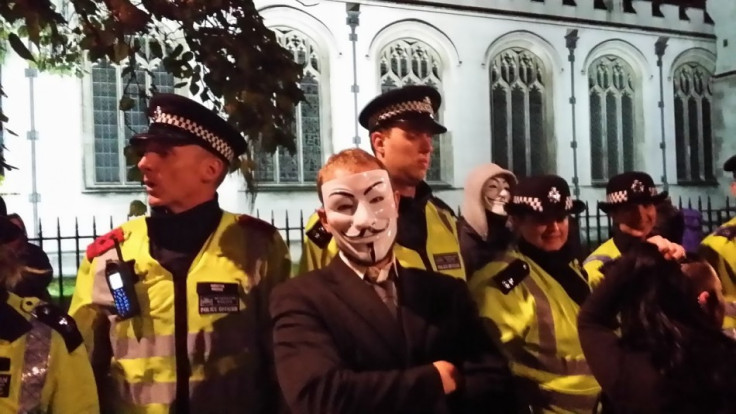Hacker, Hoaxer, Whistleblower, Spy: The Many Faces of Anonymous – Review
The definitive account of the rise of the hacktivist collective

I spoke to a real-life friend today about Anonymous and he seems to have some vision of disembodied brains held in suspension, orbiting the Earth in battle satellites or something.
This quote sums up the challenge facing Gabriella Coleman when she sat down to write Hacker, Hoaxer, Whistleblower, Spy: The Many Faces of Anonymous.
However, Coleman is more qualified that virtually anyone else in the world to speak authoritatively about the group, having spent countless hours watching, talking to and meeting the people who make up this mysterious collective.
As an anthropologist, Coleman's interest was initially piqued by the emergence of an activist sensibility within Anonymous in 2008, but by the end of this book it is clear that Coleman had become personally invested in this movement and the people who wear its mask.
Many Faces of Anonymous traces the origins of Anonymous, from its earliest days on the controversial picture board 4Chan, when its participants' main aim was trolling.
Coleman speaks of the history of this trickster archetype, tracing it back to the "mercurial Hermes and the bacchanalian Dionysus" of Greek and Roman mythology, before following it through West African and Caribbean folklore, its appearance as Loki from Nordic mythology, and onto Puck from Shakespeare's A Midsummer's Night Dream.
Coleman posits that the trolls on 4Chan were just the latest example of this character type within society – a person who was out for the laugh and to defy the rules – and that much of that sensibility is still present in Anonymous' actions today.
Misleading reporting
It was not long before the group began to display political and activist tendencies, and it was only then that Anonymous became known outside the enclosed world of online trolling.
From Project Chanology – Anonymous' campaign against the Church of Scientology – to the creation of AnonOps (a real-time chat service) and LulzSec ("black hat" hackers who attacked government and corporations), the attack on PayPal, and its involvement in the Arab Spring, Coleman charts the rise of Anonymous in meticulous detail, delivering the tale with enthralling storytelling.
From the ultimate betrayal to a former soldier posing as a14-year-old girl, the story has Anonymous has everything you could want.
As Anonymous rose in the public's perception and the more it was reported in the media, the less people really understood what Anonymous was all about. Misleading media reports "lead us further away from understanding Anonymous," Coleman says.

As the book progresses, Coleman is drawn into this online world more and more. She details her first forays in the "wildly cacophonous" world of IRC channels where all Anonymous operations are co-ordinated.
She writes about the initial mistrust and eventual friendship of the Anons she was studying, to how paranoia encroached as her dealings with them – and the likes of the FBI – became more intense.
What began as an academic project became a personal one for Coleman, which dominated her life. The result, for the reader, is a story which is in equal parts informative and enthralling.
While the writing is for the most part prosaic and procedural (necessarily so to explain the technical details of what was happening), Coleman dots the book with splashes of beautiful prose which are jarring but give us an indication of her passion for the topic.
From a beautiful passage describing an oppressive summer's day in New York as a "dystopian urban hellion", to the single best passage in the book which lays out clearly, eloquently and eruditely why Anonymous cannot just be viewed as a single, amorphous mass:
Peering through the computer, we find Anonymous in any instant to be an aggregate sack of flesh – meshed together by wires transistors and Wi-Fi signals – replete with miles of tubes pumping blood, pounds of viscera filled with vital fluids, an array of live signalling wires, propped up by a skeletal structure with muscular pistons fastened to it, and ruled from a cavernous dome holding a restless control centre, the analog of these fabulously grotesque and chaotically precise systems that, if picked apart, become what we call people.
Anonymous is an ever-changing idea. It is a platform to allow for activism online, allowing disparate people around the world to come together under a single voice which now has the power to facilitate real change.
Over the last six years we have seen thousands of news stories and features, a number of documentaries and a few books – notably Parmy Olson's We Are Anonymous – attempt to convey the essence of Anonymous with varying degrees of success.
But nothing that I have seen or read come close to Coleman's tome, in terms of opening up this world for everyone – from those who have followed the rise of Anonymous to those who know nothing about it – while making the tale entertaining and accessible.
Coleman sums up what Anonymous is better than I ever could:
Anonymous is no different from us. It simply consists of humans sitting at their glowing screens and typing, as humanoids are wont to do at this precise moment in the long arc of the human condition.
Hacker, Hoaxer, Whistleblower, Spy: The Many Faces of Anonymous is published by Verso Books and will be on sale in November for £11.89.
© Copyright IBTimes 2025. All rights reserved.






















